
- Overview
- Configuration
SQL Server
Streamline user account management with SQLServer - ADManager Plus integration
Microsoft SQL Server is a relational database management system (RDBMS) developed by Microsoft to store and retrieve data as requested by other software applications. ADManager Plus' integration with MS SQL simplifies account management for IT administrators and HR managers alike, allowing for a completely hands-free account provisioning, management, and de-provisioning.
Business intelligence
Analyze large amounts of data in diverse formats and offer a range of features that enables businesses to extract valuable insights and make informed decisions.
Hands-free user lifecycle management
Automated user lifecycle management in AD, Exchange mailboxes, Microsoft 365 accounts, and more—each in sync with the HR team's data input.
Error-free bulk user provisioning
Ensure error-free bulk user provisioning with the aid of CSV file imports with rule-based, intelligent templates.
Steps to configure Microsoft SQL Server settings in ADManager Plus:
- In ADManager Plus, click the Automation tab.
- On the left pane, select HCM Integrations.
- Under Database, click MS Sql Server.
- On the Microsoft SQL Server settings page, configure the following:
- Server Name: Enter the server name.
- Instance Name: Enter the instance name and port number.
- Authentication: Select either of the following authentication types:
- SQL Authentication: Enter the username and password for authentication.
- Windows Authentication: Enter the domain name, username, and password for authentication.
- Click Test Connection and Save to establish a connection and save the settings.
Steps to add a new configuration:
- Click the Add a new configuration button and enter a suitable name.
- Enter the details about the new configuration in the Description field.
- Configure the following details:
- Select Server: Select the server name from the drop-down menu.
- Select Database: Enter the database name.
- Table Name: Enter the name of the table in the Microsoft SQL Server database.
- Automation Category: Select the automation type from the drop-down menu.
- Fetch the input for user creation from the Microsoft SQL Server table by mapping the DB Column Name to the LDAP Attribute Name.
- Click Save to save the new configuration.
Steps to automate user creation:
- Click the Automation tab.
- Select Automation from the left pane.
- Click + Create New Automation and configure the following:
- Automation Name: Enter a name for the automation.
- Description: Add a brief note about the automation.
- Automation Category: Select User Automation from the drop-down menu.
- Select Domain: Select the domain/OUs where the automation should run. Child OUs can be eliminated by checking Exclude Child OU(s).
- Automation Task/Policy: Select Create Users from the menu.
- Select Template: Select the template to be applied for user creation.
- Location of CSV: Click the Location of CSV drop-down menu and select Data from MySQL. Select a configuration from the menu or click Add New Configuration to add new settings.
- Implement Business Workflow: Check this option if the automation has to be executed through a workflow.
- Execution Time: Configure the automation execution time and repeat the execution using the Hourly, Daily, Weekly, Monthly, or Custom options.
- Click Save to save the settings or click Save & Run to save the settings and run the automation instantly.